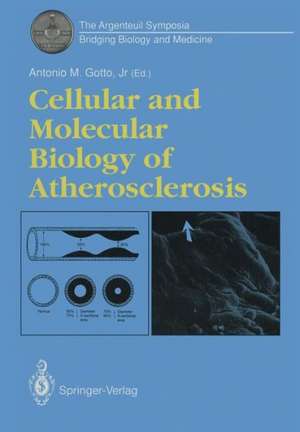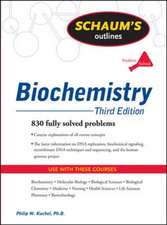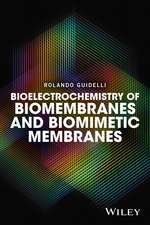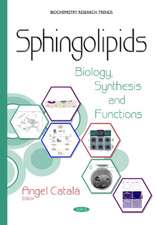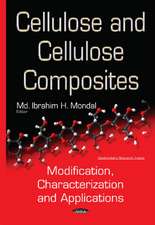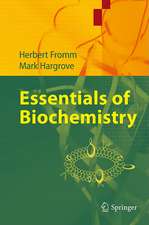Cellular and Molecular Biology of Atherosclerosis: Argenteuil Symposia
Editat de Antonio M. Jr. Gottoen Limba Engleză Paperback – 23 noi 2011
Preț: 384.31 lei
Nou
Puncte Express: 576
Preț estimativ în valută:
73.56€ • 79.93$ • 61.83£
73.56€ • 79.93$ • 61.83£
Carte tipărită la comandă
Livrare economică 21 aprilie-05 mai
Preluare comenzi: 021 569.72.76
Specificații
ISBN-13: 9781447119111
ISBN-10: 1447119118
Pagini: 200
Ilustrații: XVI, 180 p.
Dimensiuni: 170 x 242 x 11 mm
Greutate: 0.33 kg
Ediția:Softcover reprint of the original 1st ed. 1992
Editura: SPRINGER LONDON
Colecția Springer
Seria Argenteuil Symposia
Locul publicării:London, United Kingdom
ISBN-10: 1447119118
Pagini: 200
Ilustrații: XVI, 180 p.
Dimensiuni: 170 x 242 x 11 mm
Greutate: 0.33 kg
Ediția:Softcover reprint of the original 1st ed. 1992
Editura: SPRINGER LONDON
Colecția Springer
Seria Argenteuil Symposia
Locul publicării:London, United Kingdom
Public țintă
ResearchCuprins
1 Morphological Findings in the Coronary Arteries in Fatal Coronary Artery Diseas.- Number of Major Epicardial Coronary Arteries Severely Narrowed in the Various “Coronary Events”.- Quantitative Approach to Atherosclerotic Coronary Artery Disease: Amounts of Narrowing in Each 5-mm Segment of Each of the Four Major Coronary Arteries.- Distribution of Severe Narrowing in Each of the Three Longest Epicardial Coronary Arteries in Fatal Coronary Artery Disease.- Clinical Usefulness of the Quantitative Approach to Coronary Artery Disease.- Significance of Coronary Arterial Thrombus in Transmural Acute Myocardial Infarction.- Cardiac Morphological Findings in Acute Myocardial Infarction Treated with Thrombolytic Therapy.- Composition of Atherosclerotic Plaques in Fatal Coronary Artery Disease.- Effects of Percutaneous Transluminal Coronary Angioplasty on Atherosclerotic Plaques and Relation of Plaque Composition and Arterial Size to Outcome.- Morphological Findings in Saphenous Veins Used as Coronary Arterial Bypass Conduits.- 2 The L-Arginine: Nitric Oxide Pathway in Physiology and Patholog.- The Constitutive Nitric Oxide Synthase.- The Inducible Nitric Oxide Synthase.- Conclusions.- 3 Endothelial Activation: Its Role in Inflammation, Vascular Injury and Atherogenesi.- Endothelial Activation In Vivo.- Endothelial Activation and Endothelial Injury.- Endothelial Activation and Atherogenesis.- Conclusions and Summary.- 4 Basic Fibroblast Growth Factor in Vascular Development and Atherogenesi.- Vascular Injury in Atherosclerosis.- Vascular Balloon Injury and Restenosis.- Platelet-Derived Growth Factors.- Fibroblast Growth Factors.- Expression of bFGF in Vascular Development and Injury.- Prospects for Anti-bFGFs.- Targeted Toxin Therapy.- 5 The Monocyte and Endothelial Injuryin Atherogenesi.- Monocytes and Lesion-Susceptible Areas.- Morphology of Lesion-Susceptible Areas.- Endothelial Transport and intimal Accumulation in S-Areas.- Monocyte Recruitment in Lesion-Susceptible Areas.- 6 Lp [a]: A Lipoprotein Class with Atherothrombotic Potentia.- Structural Properties of Lp [a].- Lp [a] Physiology.- Lp [a] as a Cardiovascular Pathogen.- Considerations on the Thrombo-atherogenicity of Lp [a].- Diagnostic Considerations.- Approaches to Correct High Plasma Levels of Lp [a].- 7 Modified Lipoproteins and Atherogenesi.- Methods.- Results.- Discussion.- 8 The Molecular Biology of Apolipoprotein.- Hepatic Apo B Metabolism.- Structure and Function of Hepatic Apo B-100.- Intestinal Apo B-48 Metabolism.- Conclusions.- 9 Structure and Evolution of the Apolipoprotein and Lipase Gene Familie.- Methods.- The Soluble Apolipoprotein Multigene Family.- Structure and Evolution of the Lipase Gene Family.- Concluding Remarks.- 10 A Gln to Arg Substitution in the Adducin Family of Proteins is a Necessary but not Sufficient Factor for High Blood Pressure in Rats of the Milan Hypertensive Strai.- Results.- Discussion.- 11 Genetic Control of Plasma Lipid, Lipoprotein and Apolipoprotein Levels: From Restriction Fragment Length Polymorphisms to Specific Mutation.- Background.- The Apo B Protein.- The ApoB Gene.- Apo B Protein Polymorphism.- Linkage Disequilibrium.- Apo B Gene Sequencing.- Conclusions.- 12 Receptor Regulation of Lipoprotein Metabolis.- Separate Pathways for Exogenous and Endogenous Lipids.- Postulating a Chylomicron Remnant Receptor.- Studies on Chylomicron Remnant Catabolism.- Characterization of LRP as the Potential Chylomicron Remnant Receptor.- Structural Features of LRP.- Regulation of LRP.- Conclusion.- 13 The High-Density Lipoprotein Recepto.- High-Density Lipoprotein Receptor Hypothesis.- Methods.- High-Density Apolipoproteins Stimulate Translocation and Efflux of Intracellular Sterol.- Intracellular Signals in High-Density Apolipoprotein-Mediated Sterol Translocation and Efflux.- The High-Density Lipoprotein Receptor.- Clinical Implications.- 14 High-Density Lipoprotein Cholesterol, Triglycerides and Coronary Heart Disease.- 15 Apolipoproteins, Reverse Cholesterol Transport and Coronary Heart Diseas.- The Role of the Apo A1/C3/A4 Gene in Association Studies and Cosegregation Studies.- The Role of Apo A-I Mutants.- Molecular Defects in HDL Cholesterol Deficiency Syndromes.- Conclusions.- 16 Cholesterol-Lowering Clinical Trials: Where Do We Go From Here?.- Some Previous Venues.- Future Directions.
